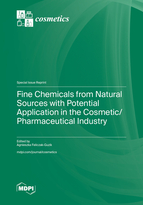Fine Chemicals from Natural Sources with Potential Application in the Cosmetic/Pharmaceutical Industry
A special issue of Cosmetics (ISSN 2079-9284). This special issue belongs to the section "Cosmetic Formulations".
Deadline for manuscript submissions: closed (31 December 2023) | Viewed by 89580
Special Issue Editor
Interests: fine chemicals; cosmetics products; renewable sources; nanomaterials; catalysis
Special Issues, Collections and Topics in MDPI journals
Special Issue Information
Dear Colleagues,
It is beyond any doubt that chemistry has provided countless products improving the quality of human life in practically all areas. Unfortunately, some of the products have proved to be hard to dispose of, not biodegradable or toxic. Recently, much care has been taken to ensure that chemical products should be first of all safe for humans. According to one of the approaches the cosmetic/pharmaceutical products used should be based on natural raw materials. With the use of physical, chemical, and biochemical processes, these raw materials can be transformed into intermediates that are later used to produce high-value chemicals, polymers, lubricants, solvents or surfactants, and special products, which until now have been obtained using fossil fuels.
Dr. Agnieszka Feliczak-Guzik
Guest Editor
Manuscript Submission Information
Manuscripts should be submitted online at www.mdpi.com by registering and logging in to this website. Once you are registered, click here to go to the submission form. Manuscripts can be submitted until the deadline. All submissions that pass pre-check are peer-reviewed. Accepted papers will be published continuously in the journal (as soon as accepted) and will be listed together on the special issue website. Research articles, review articles as well as short communications are invited. For planned papers, a title and short abstract (about 100 words) can be sent to the Editorial Office for announcement on this website.
Submitted manuscripts should not have been published previously, nor be under consideration for publication elsewhere (except conference proceedings papers). All manuscripts are thoroughly refereed through a single-blind peer-review process. A guide for authors and other relevant information for submission of manuscripts is available on the Instructions for Authors page. Cosmetics is an international peer-reviewed open access semimonthly journal published by MDPI.
Please visit the Instructions for Authors page before submitting a manuscript. The Article Processing Charge (APC) for publication in this open access journal is 1800 CHF (Swiss Francs). Submitted papers should be well formatted and use good English. Authors may use MDPI's English editing service prior to publication or during author revisions.
Keywords
- natural sources
- application in the cosmetic/pharmaceutical industry
- fine chemicals
- active substances
Benefits of Publishing in a Special Issue
- Ease of navigation: Grouping papers by topic helps scholars navigate broad scope journals more efficiently.
- Greater discoverability: Special Issues support the reach and impact of scientific research. Articles in Special Issues are more discoverable and cited more frequently.
- Expansion of research network: Special Issues facilitate connections among authors, fostering scientific collaborations.
- External promotion: Articles in Special Issues are often promoted through the journal's social media, increasing their visibility.
- Reprint: MDPI Books provides the opportunity to republish successful Special Issues in book format, both online and in print.
Further information on MDPI's Special Issue policies can be found here.






